Without a doubt, guppy fish (Poecilia reticulata) are among the most popular aquarium fish out there.
Their appeal comes from many aspects. First and most obvious is their amazing range of vibrant colors, patterns, and fin shapes.
A school of these fish against a live green plant backdrop makes for a gorgeous tank display!

Second, they are peaceful and amenable community fish that can be paired with other similarly sized tank mates.
Finally, they are hardy, adaptable to a range of water conditions, and ultimately easy to care for.
Guppies are known as “million fish,” if this gives you any insight into their ability to reproduce in captivity.
As such, it is beneficial for you to know how to distinguish male from female guppies.
Not only can this help in terms of controlling breeding, but it can also help in mitigating potential aggression by maintaining proper male to female ratios.
Fortunately, there are ways to determine which of your guppies are male and female.
Keep reading to learn about distinguishing characteristics.
In this article
Body Shape and Size

One way to differentiate between male and female guppies is by examining their body shape.
Female guppies are generally larger in size, growing to around 2.1 inches (5.3 cm) in length.
Their bodies are more rounded in shape, especially when they are pregnant with baby guppies.
Males are smaller in size overall, reaching only 1.1 inches (2.8 cm) in length.
Male guppies’ bodies are slender and streamlined, giving them a distinctly different body shape next to the rounder females.
Fin Shape
In domestic guppies, the fin shapes of male and female guppies are quite different.
You will find variations in the anal, dorsal, and tail fins.
Anal Fins
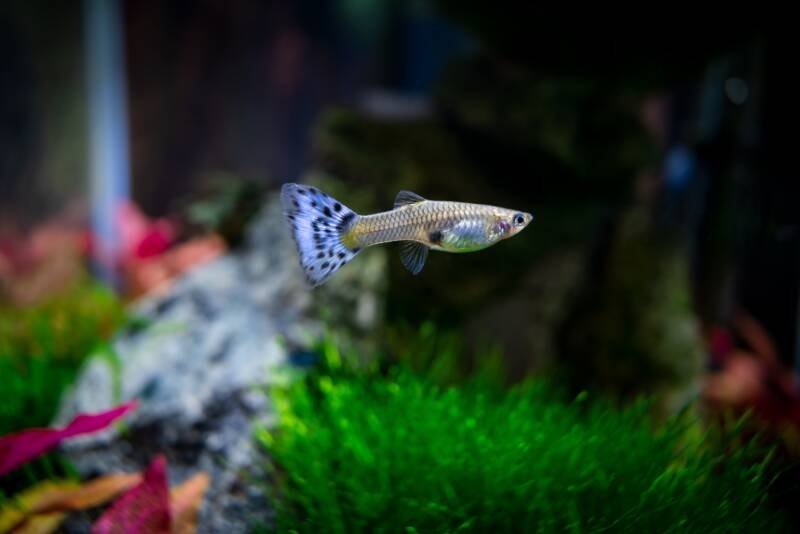
To locate the anal fin, look on the underside of the guppy’s body, just in front of the tail fin.
Male guppies will have a pointed anal fin. The females’ fins will be a blunt, triangular shape.
Dorsal Fins
To locate the dorsal fin, look at the top side of the guppy’s body.
The dorsal fin is typically located one third to one half of the way back on the body from the head.
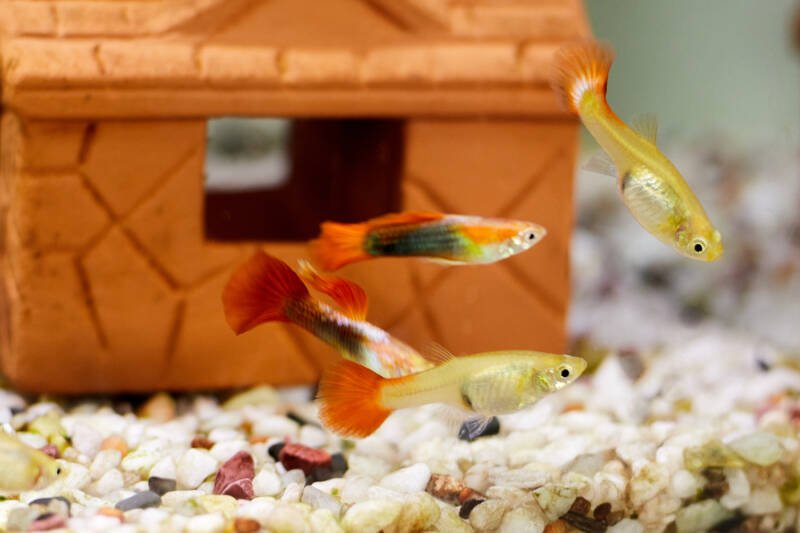
Males have longer, more ornate dorsal fins. Depending on the type of guppy, these fins can be quite elaborate and flowing.
The dorsal fins of females tend to be shorter, with softly rounded edges.
Tail Fins
Tail fins are another great way to differentiate between male and female guppies.
Males’ tail fins, much like the dorsal fins, will be larger, wider, more colorful, and graceful. Females’ tail fins are stout and rounded.
Reproductive Organs
A key method for differentiating between male and female guppies is to locate and identify their reproductive organs.
Look for the gravid spot on the female and the gonopodium on the male.
Gravid Spot
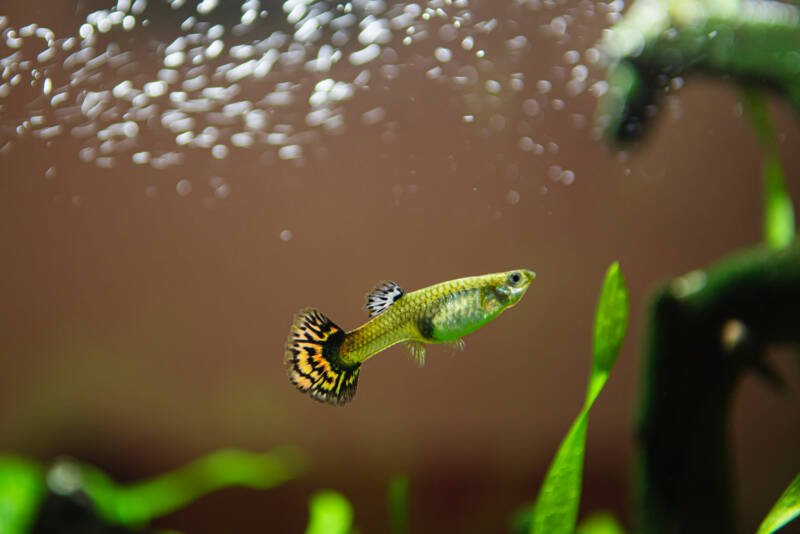
The gravid spot is a dark spot located on the underside of a female guppy’s body.
To find the gravid spot, look slightly forward of the anal fin.
When a female reaches reproductive age, you should be able to locate the gravid spot easily.
When your guppy is pregnant, this spot will be significantly more visible and will darken as the time approaches for her to give birth. Afterwards, the color may fade somewhat.
Identifying the gravid spot is an excellent way to determine which of your guppies are female.
After mating, a female can retain the male’s sperm for up to six months, meaning that she will almost continually be pregnant and therefore show a prominent gravid spot.
Gonopodium

Depending on the maturity of the male, you may see the thin gonopodium co-located with the anal fin. It appears as a long, tube-shaped protrusion.
The gonopodium is the male’s sex organ, which is used to inseminate the female.
Coloration
In general, guppies have different color patterns to indicate which are male and female.
The male is the one that will sport the array of gorgeous colors that define guppy fish.
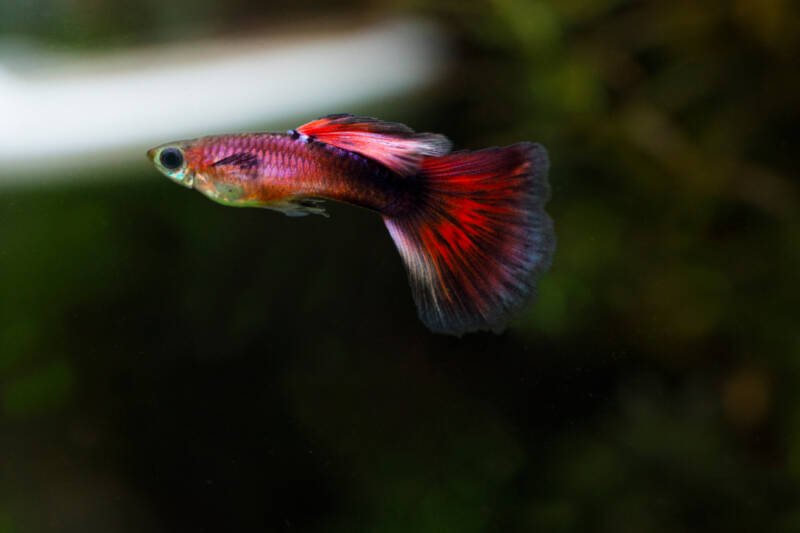
These fish come in a rainbow of hues, including red, blue, purple, black, yellow, orange, and any combination thereof.
Females are subtly colored but beautiful in their own way.
While some variations have a brown or light overall color, others can have fancy tail colors and patterns.
In the wild, the colors and patterns displayed by males are an adaptation intended to attract females for mating.
In domestically bred guppies, selective breeding has highly accentuated this natural coloration, leading to the wonderful variety we know.
As such, the color differentiation may be more prominent in captive bred guppies than in wild caught specimens.
While color variation is one way to tell the difference between male and female guppies, it is not always an accurate indicator of sex as in some guppy species, the female is also brightly colored. In these cases, look for other indicators.
Mating Behavior
As we mentioned, guppies excel at producing fry.
With their short lifespan of two to five years, they reach reproductive age fairly quickly.
Females can reproduce once they reach the age of two to three months. Males are sexually mature at only seven weeks of age.
If your guppies have reached these age milestones, in addition to their physical characteristics, you can also observe mating behavioral characteristics that will indicate which of your fish are male or female.
Male mating behavior involves an extended, complex dance in which he tries to impress the female by flaring, chasing, and flexing.
Novice aquarists may mistake these actions for aggression.
Although the male is persistent, mating will only occur once the female has consented.
The male will then fertilize the female using his gonopodium. This process is quick and effective.
The female will retain sperm within her reproductive system for several months and can produce multiple batches of offspring from a single encounter.
Over the next twenty-one to thirty days following this ritual, you will observe your pregnant females swell as they prepare to give birth.
The number of resulting fry can be upwards of 200!
What Ratio of Male and Female Guppies is Best?
Knowing which of your guppies are male or female is vital to ensure proper sex ratios in the tank.
As the males’ focus is courting the females, having too many male fish in a tank means they will continuously chase and harass the fewer females.
The resulting increase in stress for the females leaves them at higher risk for contracting diseases.
Higher numbers of males can also lead to an increased risk of aggression as the males attempt to outperform their counterparts.
To better ensure peace within your tank, plan on a male to female ratio of 1:3; that is, one male for every three females in the tank.
This will allow the males’ attention to be divided among the females and gives the females a break from constant attention.

Differences Between Wild and Domestic Guppies
Most of the guppy specimens you will find in the aquatic trade are domestically bred.
These breeding practices have resulted in the extraordinarily colorful varieties and the fancy fins we come to expect with this breed.
However, in the wild, the traits of domestic guppies would not be beneficial as the fin size and shape would impede movement and the vibrant coloration would attract unwanted attention, thereby increasing their predation risk.
That is not to say wild guppies do not possess any color.
Females have melanophores in their scales that leave them more subtly colored and able to better blend into their environment.
Males, on the other hand, display various colors and patterns to appeal to female mates.
A study by Kottler, et al. looked at guppy populations around the island of Trinidad.
Results indicated that females were attracted to males displaying orange and iridescent pigments. The females were attracted to these bright hues because they can indicate a male’s health and vitality.
Distinguishing Between Male and Female Guppy Fry
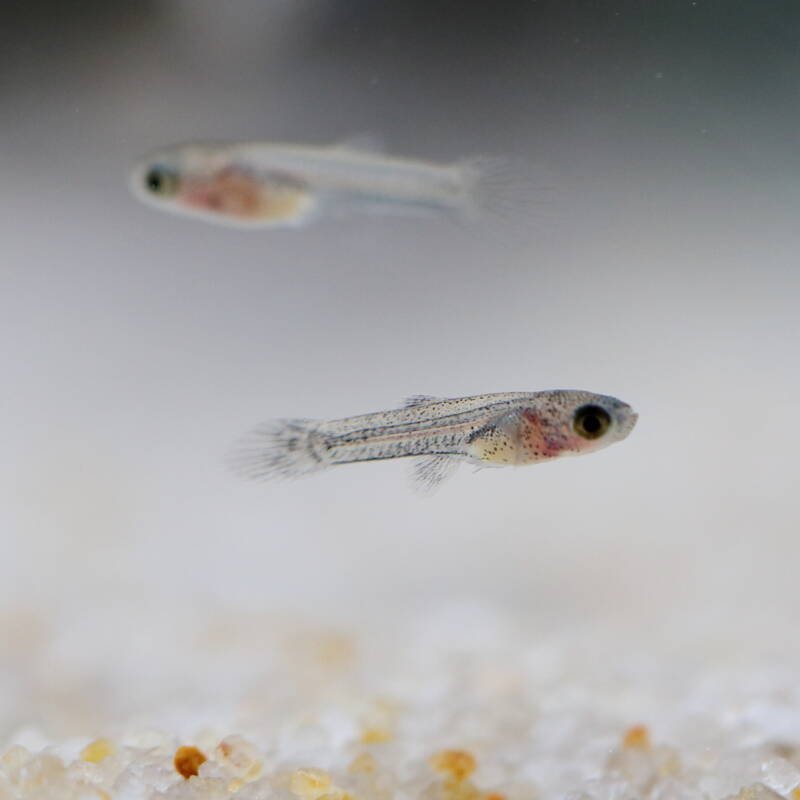
This can be a challenging activity. Male and female guppy fry look identical for approximately the first four weeks of life.
After that time, they begin to display secondary characteristics, such as the gonopodium and gravid spot.
Sometimes, it can be difficult to see a female’s gravid spot, particularly when they are young.
Try shining a flashlight behind the fish and using a magnifying glass to determine if there is a dark spot near her tail.
While there are indications that water temperature can influence the resulting ratio of male to female fry, the science is still unfolding in giving a definitive answer.
Closing Thoughts
Knowing the difference between your male and female guppies is advantageous for several reasons, including ensuring proper male to female ratios and controlling breeding opportunities.
Fortunately, there are several ways to determine which fish are male and which are female.
Looking at body shape and size, fin shape, coloration, reproductive organs, and mating behaviors will help you know which fish is which.
Once you have made that determination, you can plan the best tank configuration.
We would love to hear from you!
Have you ever had difficulties telling your male from female guppies?